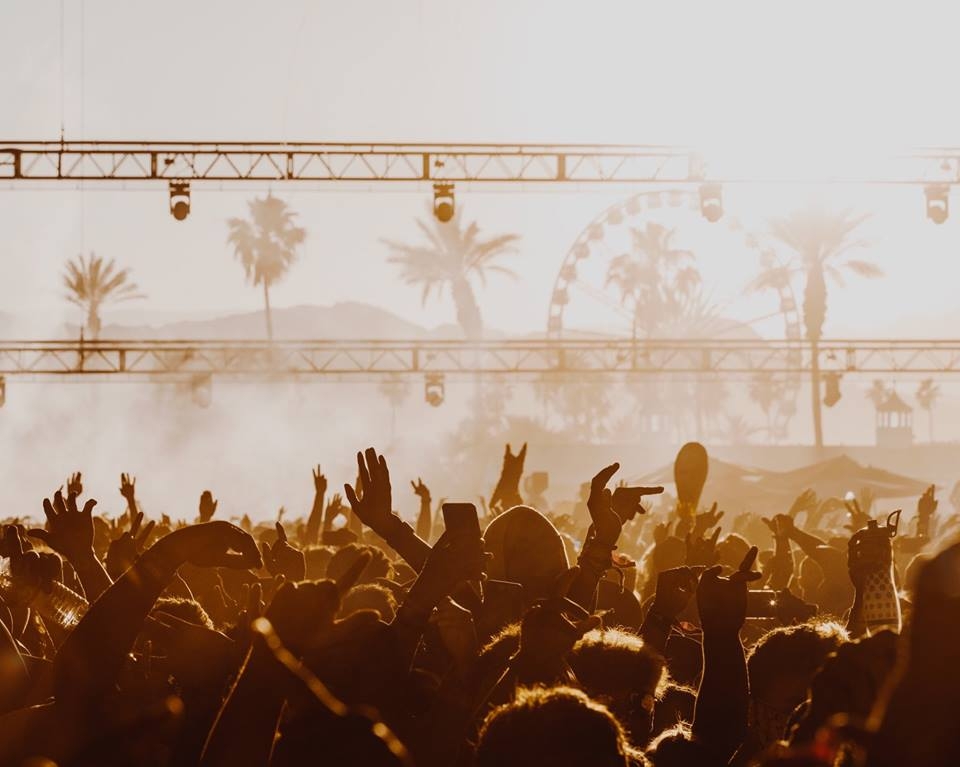TOP 7 Most Popular Holidays in India
 |
| Photo: Thegrandindianroute.com |
At any time of the year, all over the country, Indian festivals celebrating religion, the phases of the moon, culture, the seasons, India’s epic stories (the Ramayana and the Mahabharat) pop up with astonishing frequency. The festivals of India are one of the truly great things about India, according to Breathedreamgo.
Indian Festivals may all celebrate different things, but they have one thing in common: they’re a spectacle to behold. These are festivals well worth visiting India to experience.
1. Diwali Festival
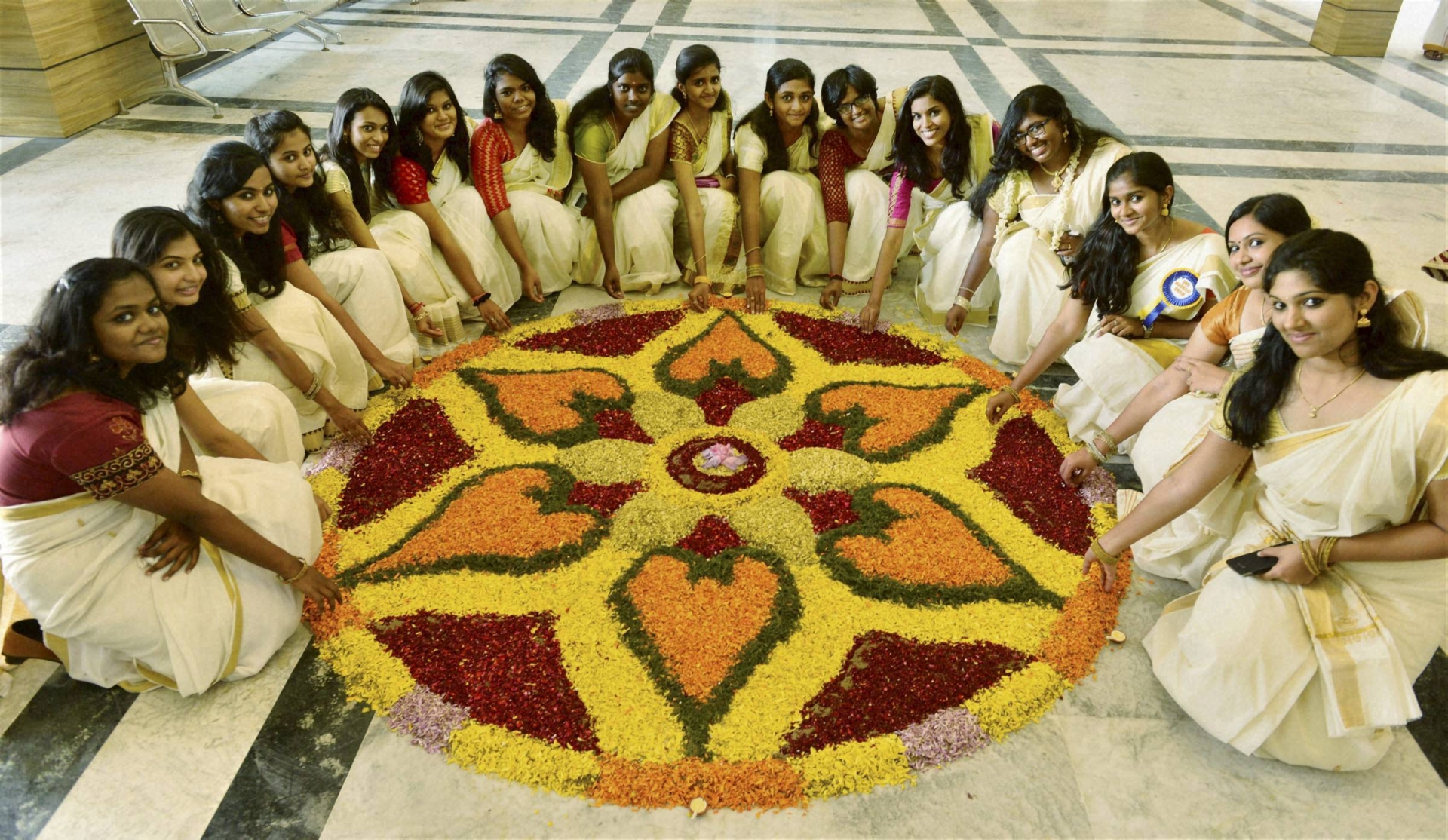 |
| Photo: Blog.travelguru.com |
Diwali is the biggest Indian Festival, a celebration of the triumph of light over dark, good over evil. The word Diwali means “rows of lighted lamps” and it is also called the Festival of Light. People light small diyas (lamps) and fireworks to help guide Lord Rama home from exile.
Diwali is basically the equivalent of Christmas — a big, festive celebration that brings families together and is the highlight of the holiday season. There are five days of festivities, each marked with different pujas (prayers) and rituals.
When is Diwali?
As per India’s official holiday calendar, Diwali in 2020 will be on Saturday, November 14, coinciding with the 15th day of Kartik, the holiest month in the Hindu lunar calendar, Aljazeera reported.
In Sri Lanka and Singapore, Diwali will also be observed on November 14, which is an official holiday in Malaysia, Myanmar, Nepal and the Sindh province in Pakistan.
In the Gregorian calendar, the Diwali festival always falls between mid-October and mid-November.
What does it commemorate?
Hindus celebrate the triumph of good over evil – of light over darkness – to mark the return of Ram, the lord of virtue, to his kingdom after 14 years of exile.
Followers of Jainism commemorate Mahavira, a venerated ascetic who fundamentally reformed the faith, reaching a state of nirvana after his death.
Sikhs use Diwali to mark the anniversary of the release from prison of Guru Hargobind in 1619.
For Buddhists, this day represents the time Emperor Ashoka gave up everything and adopted a path of peace after going through bloodshed and death. The day is observed as Ashok Vijayadashami.
How is it celebrated?
Traditional earthen diyas or candles are lit, and nowadays, fireworks are set off.
Houses are cleaned and decorated with colourful rangoli artworks – patterns created on the floor using coloured rice or powder.
Throughout India, and in Indian communities, people wear new clothes, visit friends and family, and exchange sweets and gifts.There is also a strong belief in giving to those in need.
A special “puja” prayer is dedicated to the goddess Lakshmi in the evening. She is said to bring good luck and prosperity.
2. Onam
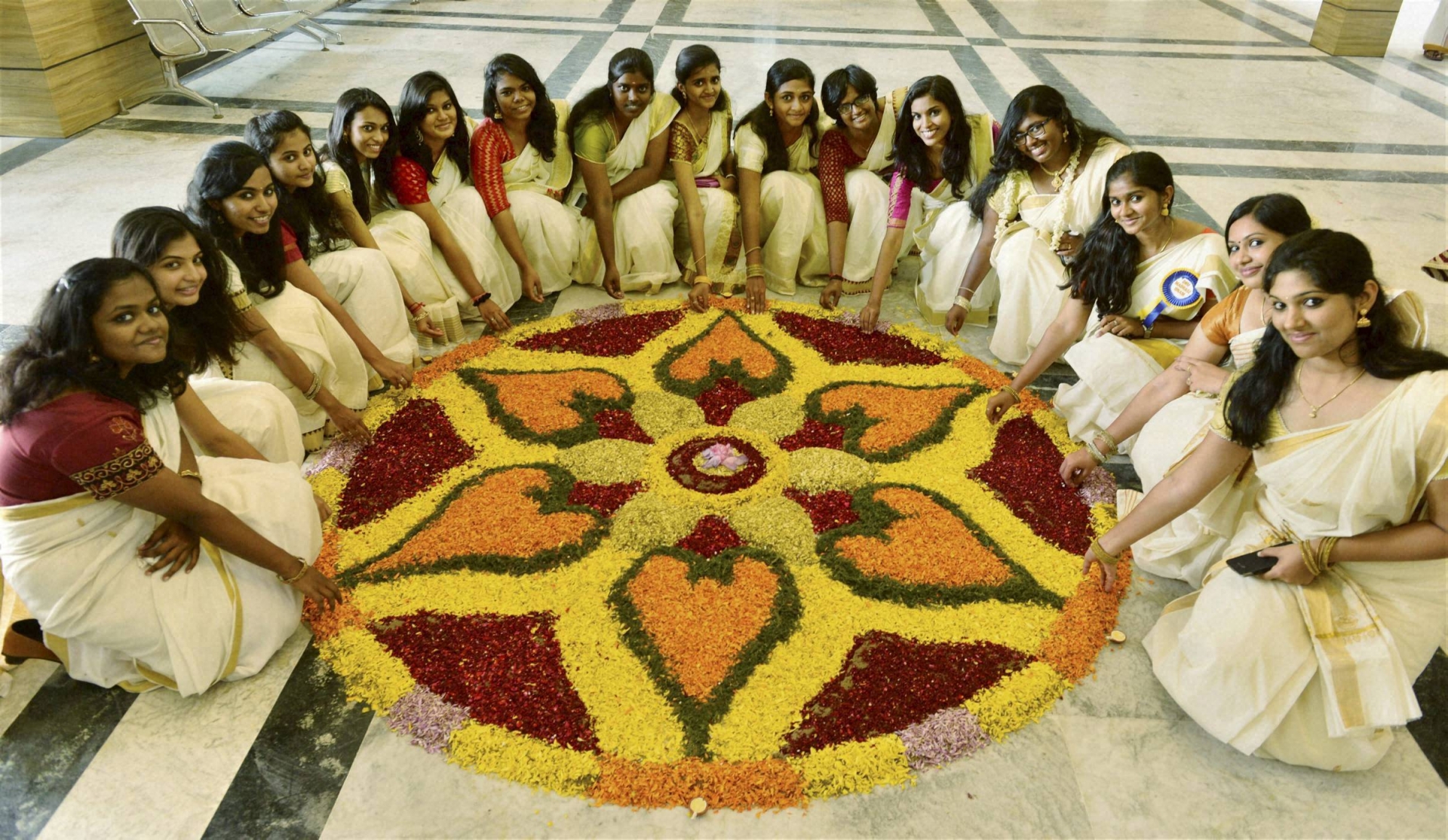 |
| Photo: Business-standard.com |
The biggest festival of Kerala, Onam marks the onset of the harvest season. It is also celebrated to remember King Mahabali, whose spirit is believed to visit his people during this time. Onam celebrations include a lot of fanfare and gaiety, including boat races, floral arrangements, worshiping, dancing, and enjoying elaborate feasts with friends and family. This year, the celebrations leading up to Onam will begin Saturday, August 22 onwards and Thiruvonam will be celebrated on August 31.
Significance of Onam celebrations
According to Vaishnava mythology, King Mahabali defeated the Gods and began ruling over all three worlds. King Mahabali was a demon king who belonged to the Asura tribe. The kind-hearted king was much-loved by the people. The Gods got insecure of King Mahabali’s popularity and Lord Vishnu to step in and help contain Mahabali, HindustanTimes reported.
Lord Vishnu took on his fifth avatar, in the form of the Brahmin dwarf Vamana, and paid a visit to King Mahabali. King Mahabali asked Vamana what he wished for, to which Vamana responded, “three pieces of land”. When Vamana was granted his wish, he grew in size and in his first and second pace respectively, he covered the sky, and then the netherworld.
When Lord Vishnu was about to take his third pace, King Mahabali offered his own head to the God. This act impressed Lord Vishnu so much that he granted Mahabali the right to visit his kingdom and people every year during Onam festivities.
Rituals of Onam
During the ten-day festivities, devotees bathe, offer prayers, wear traditional clothes -- women of the household wear a white and gold saree called the Kasavu saree - participate in dance performances, draw flower rangolis called pookkalam and cook traditional feasts called sadya. Sadya is served on banana leaves during Onam.
The 10-day festivities also see people participating in boat races called Vallam Kali, Tiger dances called Pulikali, worship the God or Onathappan, Tug of War, Thumbi Thullal or women’s dance ritual, Mask dance or Kummattikali, Onathallu or martial arts, Onavillu/music, Onapottan (costumes), folk songs among other fun activities.
The traditional feast
The traditional Onam sadya (feast) is a 9-course meal that consists of 26 dishes. It includes Kalan (a sweet potato and yam coconut curry dish), Olan (white gourd prepared in coconut curry), Avial (seasonal vegetables in coconut curry), Kootu curry (a dish made of chickpeas), rasam (a soup-like dish made with a base of tomato and pepper, eaten with rice and other preparations) and the much-loved dessert, Parippu payasam (a rice kheer preparation).
This year, however, owing to the Covid-19 pandemic, people have been advised to celebrate Onam within their homes and use locally available flowers for the traditional floral carpet.
Read more: 10 Most Dangerous Religious Festivals In India
3. Durga Puja
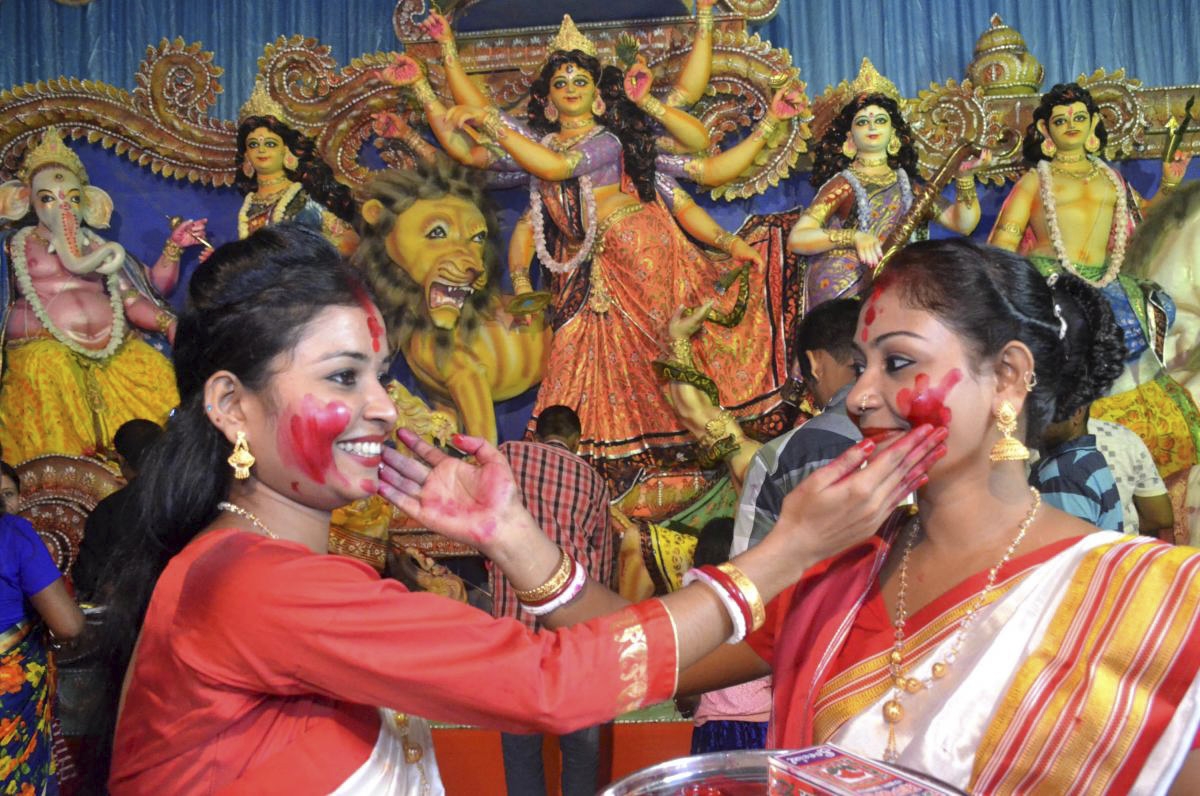 |
| Photo: Travelbeginsat40.com |
Durga Puja is truly one of the great festivals of India, and though not as well known as Diwali and Holi, has a lot to offer visitors. Kolkata (formerly Calcutta) in West Bengal is THE place to celebrate Durga Puja. The festival honours the goddess Durga, who represents the divine feminine energy, or shakti — the force, power and warrior aspect of the divine mother.
Why is Durga Puja celebrated?
Like most other Indian festivals, the celebration of Durga Puja, too, dates its origin to the days of mythology.
When the shape-shifting demon king Mahisarur’s torment on the divine beings in Heaven escalated, Goddess Durga (re-incarnation of Devi Parvati) emerged to slay the asura and protect Heaven and the mortal world from his atrocities. The battle ended with the victory of Goddess Durga, the ‘destroyer of evil’, thus starting off a tradition of worshiping her on Durga Puja or Durgotsav.
How is Durga Puja celebrated?
Celebrations for the Durga Puja begin months ahead with the construction of artistic idols and ornate pandals (the main shelter erected for the idols). Puja shopping for new clothes and shoes are a must, with families gifting each other puja gifts. Few days before the main celebration begins, fairs, street food joints, and countless pop-up stores are up in the festive fervor with streets and colonies lit up with colorful lights.
Prayers are offered to Goddess Durga every day, with each day signifying a new something. Side by side, devotees also worship Saraswathi, Lakshmi, Ganesha, and Karthik, who are children of Devi Durga.
Apart from attending pujas within the complexes, people go pandal hopping to witness the artistic creations as each pandal and idol have unique and remarkable themes for the occasion. Kolkata, for one, never fails to astonish the onlookers with beautifully decorated pandals and idols, be it at Shobhabazar Raj Bari, Deshapriya Park, or Maddox Square Park.
Durga Puja 2020 dates
Durga Puja is a 10-day festival altogether. However, most of the significant celebrations take place in the last five days, starting from Maha Shashti.
Mahalaya – 17th September
Mahalaya precedes the main days of celebration of Durga Puja and marks the Agomoni or welcoming of Goddess Durga and her children (Lakshmi, Ganesh, Saraswati, and Kartik) from Kailash mountain to her natal home. As this day marks the start of her descent journey to her mortal devotees, artisans start painting the eyes of the goddess’ idol, an event known as chokkhudan.
While on most years, Mahalaya falls around six days before the main puja on Maha Sashthi, the year 2020 had been an exception. Mahalaya, which heralds the start of Devi Paksha, was observed on September 17, and Maha Sashthi falls on October 22. The 35-day gap is due to the timings of the Mala Maas (unholy month) during which the Puja cannot be done.
Maha Shashti – 22nd October
The sixth day or Shashti is when the deity is unveiled in front of the public. Prayers and rituals are observed such as playing of dhaks (a kind of drum) by the dhakis, with one of the prime events of the day being Mahisasur Mardini, a theatrical enactment with songs and plays of Goddess Durga vanquishing the evil.
Maha Saptami – 23rd October
The seventh day or Maha Saptami constitutes the ceremonial bath of the banana tree (also called Kola Bou for the occasion), draped in a red-bordered sari, and placing her beside the idol of Ganesha.
Maha Ashtami – 24th October
On the eighth day or Maha Ashtami, it is believed that Goddess Durga defeated Mahisasur. All devotees start off the day with Pushpanjali (flower offerings) in the morning, and then in the afternoon, feasts are organized. Khichdi (a dish of rice and lentils cooked together), curries, and other delicacies are served to all.
Maha Navami – 25th October
The culmination of Sandhi Puja announces the start of Navami. Large throngs of people gather to witness the Maha Aarti. Consequently, lots of puja committees also organize Dhunuchi (incense burner) dance competitions in the evening of Navami.
Maha Dashami – 26th October
Dashami is the day of bidding goodbye to the Goddess and awaiting her arrival once again the next year. Before the idol immersion or visarjan, women smear each other with red colors (the event is known as sindur khela), and the idols are carried out on a procession with music playing, dhaks beating, and people dancing to the beats.
The idols are then immersed in the holy Ganges as fireworks and crackers are burst. People exchange greetings and wish each other prosperity on this day. They carry sweets for their friends and family while children of the house seek the blessings of the elder.
The celebrations are slightly varied in different parts of the country. Many places in the northern and western parts of India observe it as Navratri over a span of nine days (Gujarat is well-famed for Navratri and Garba dances during this time), followed by Dussehra on the 10th day. Here too, the day marks the victory of the good over evil as people put effigies of Ravana ablaze.
*Read More: TOP 15 Most Popular Holidays and Festavals in India
4. Ganesh Chaturthi
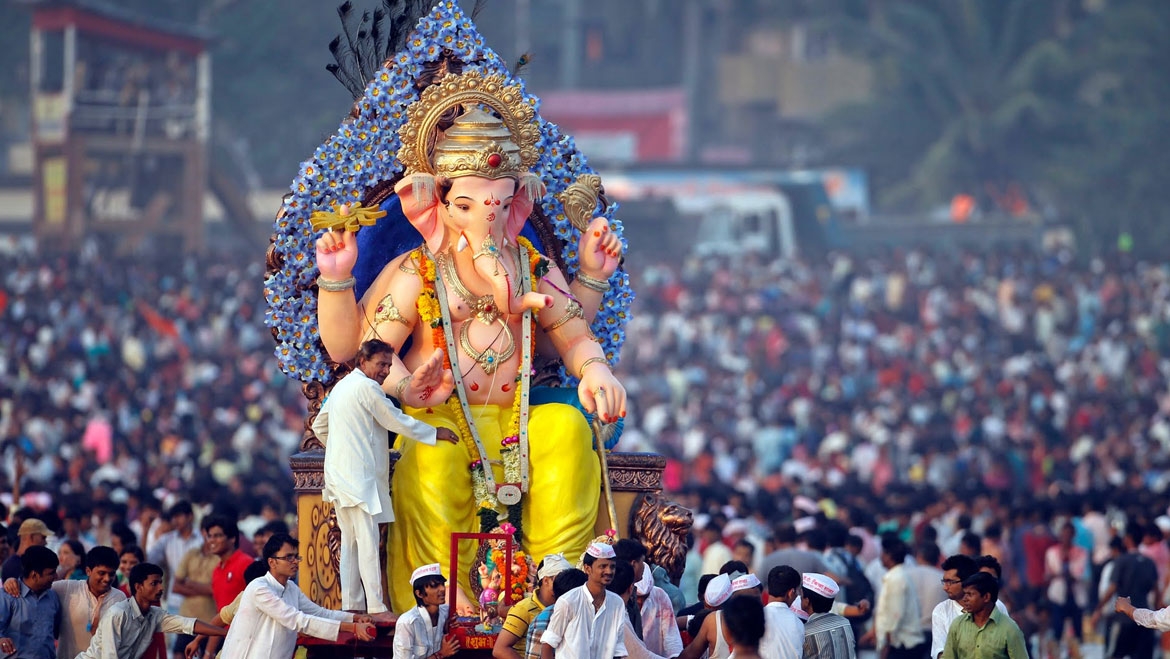 |
| Photo: Tourmyindia.com |
Ganesh is the beloved elephant-headed god, a favourite throughout India, and Ganesh Chaturthi is the Indian festival that honours him. It runs for 11 days in late August or September, depending on the cycle of the moon. In 2020, it begins on August 22 and culminates on September 1.
Similar to Durga Puja, images of Ganesh are made throughout the year and displayed during the 10-day festival. On the 11th day, called Ganesha Visarjan or Anant Chaturdasi, the images are paraded through the streets, accompanied by singing and dancing, and finally immersed in the sea.
Traditions
The excitement for this 10-day long festival begins weeks before Ganesh Chaturthi, with several people making clay idols of Lord Ganesha and painting them. There is more consciousness in terms of organic choices for the Ganpati idol, as the erstwhile methods have been found to deeply affect marine life and pollute the environment, according to HindustanTimes.
A Mumbai-based group is offering an alternative to Plaster of Paris (PoP) via seed balls placed inside Ganesh idols that can grow into plants after immersion. Sprouts Environment Trust, since 2015, has run an initiative called God Save the Ocean using ingredients such as corn and vegetable powder in idol-making that can easily dissolve in sea water and get consumed by marine organisms. The idols are organically-coloured with substances such as turmeric, chandan and geru (coloured soil) to protect the aquatic biodiversity. These eco-initiatives are also being followed in Indore and Lucknow where Ganpati idols have been made using tulsi seeds, giloy and more.
Other initiatives include Chocolate Ganesha, proceeds of which are often distributed amidst the underprivileged.
Originally, Ganesh Chaturthi is known to be celebrated in a large way in Maharashtra and Andhra Pradesh, but the festival and festivities have spread far and wide, with devotees celebrating in other parts of the country with equal fervour.
The festival begins with Pranapratishhtha, which consists of the chanting of mantras by a priest. Offerings which are known to be loved by Lord Ganesha are placed infront of his idol. These include modak, shrikhand, payasam, coconut rice, motichoor laddoo and other sweets.
Devotees throng to temples and special pandals set up for Ganesh Chaturthi to pay their respects to the Lord Ganesha. People also sometimes choose to bring Ganpati home ahead of the festival and host him for the 10-day festivities.
On the tenth day, Lord Ganesha’s statue is immersed in water, known as Ganpati Visarjan. Devotees chant Ganapati Bappa Morya, paying respect to him as he is seen off, taking all our worries away and leaving blessings behind.
| This year, amid the coronavirus pandemic, the Brihan Mumbai Municipal Corporation (BMC) has introduced a one-ward-one-Ganpati concept to maintain social distancing. Public celebrations for Ganeshotsav are barred in New Delhi this year. Ganesh Chaturthi date, time Ganesh Chaturthi date: August 22, 2020 Ganesha Visarjan Date: September 01, 2020 |
5. Pushkar Camel Fair
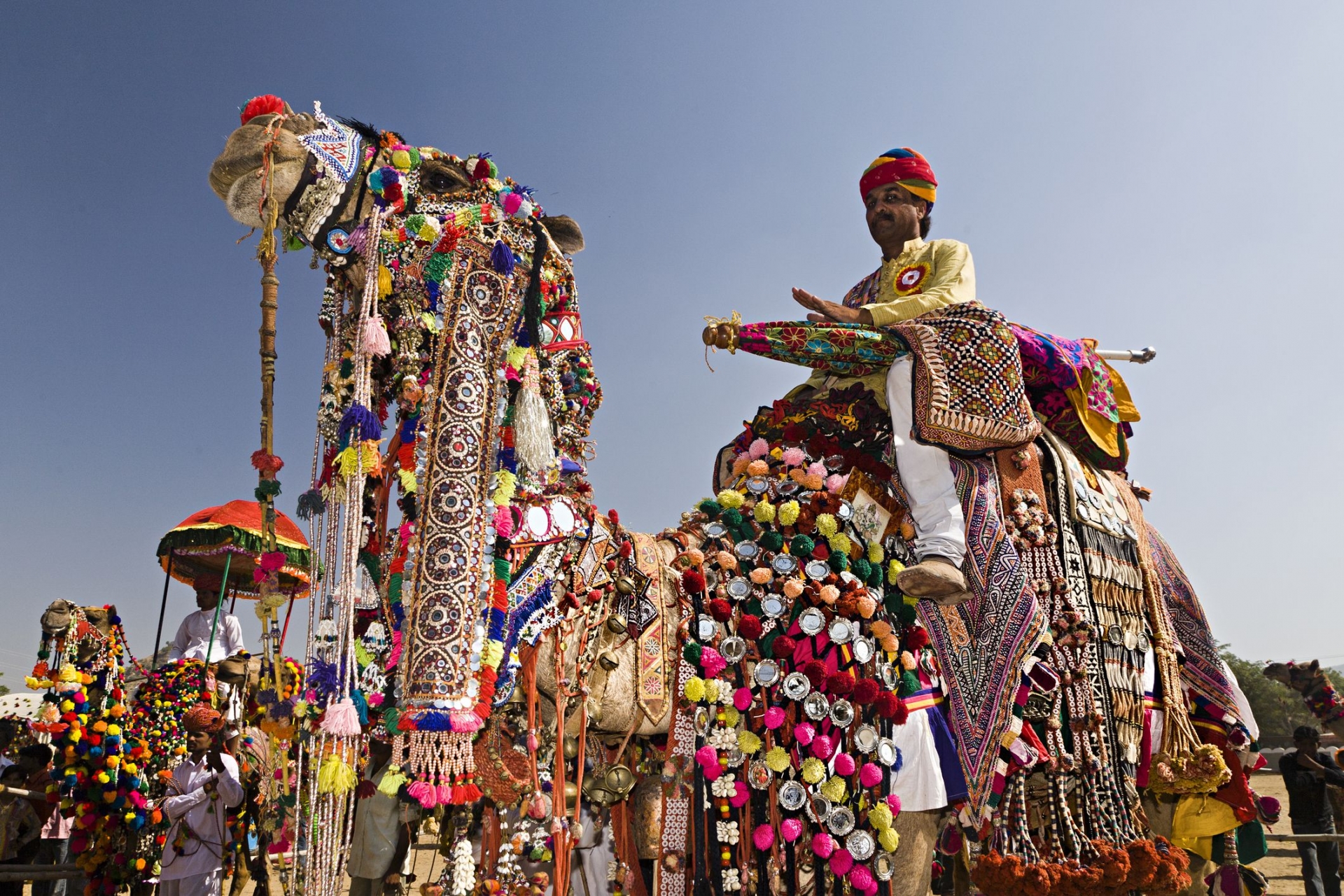 |
| Photo: Tripsavvy.com |
Pushkar is a small town in rural Rajasthan famed for the beauty of its lake, the uniqueness of its Brahma Temple (the only one in India) and the chilled-out vibe. Many people come here just to BE … and I am no exception. I have been known to spend days relaxing on rooftops, watching the sunrise on the lakeside ghats, and just being…
The Pushkar Camel Fair takes over the town each autumn, at the time of the Kartik Purnima (full moon festival). This means that a religious festival and livestock fair converge on the small town at the same time and turn it into a giant mela (fair).
When is the Pushkar Camel Fair
Usually in November, depending on the cycle of the moon. The camel action takes place during the first few days of the festival, after which time the focus shifts to heightened religious celebrations, according to Tripsavvy.
In 2020, the official dates for the Pushkar Fair are November 22-30. Be sure to come early to see the fair in full swing! Camels and other livestock will start arriving up to five days before the official start of the fair -- that is from November 17, 2020.
Find out detailed information about the Pushkar Fair dates, including what happens on each day and when the festival will be held in future years.
Where and How is the Fair Celebrated?
In Pushkar, near Ajmer on the edge of the Thar Desert in Rajasthan.
Most of the activities take place at the fairground, located to the west of town near the intersection of Brahma Temple Road and National Highway 89. The camels are dressed up, paraded, shaved, entered into beauty contests, raced, made to dance, and traded. A huge carnival is held, with an array of musicians, magicians, dancers, acrobats, snake charmers and carousel rides to entertain the crowd.
Rajasthan Tourism publishes a program of events before the festival, which can be obtained for free from your accommodations in Pushkar.
What Rituals are Performed During the Fair?
Pilgrims come to this festival to bathe in the holy water of Pushkar's lake and be absolved of their sins. The two days around the full moon are considered to be the most auspicious time of the year for bathing in the lake. Those who bathe on the day of the full moon are said to receive special blessings.
6. Navaratri
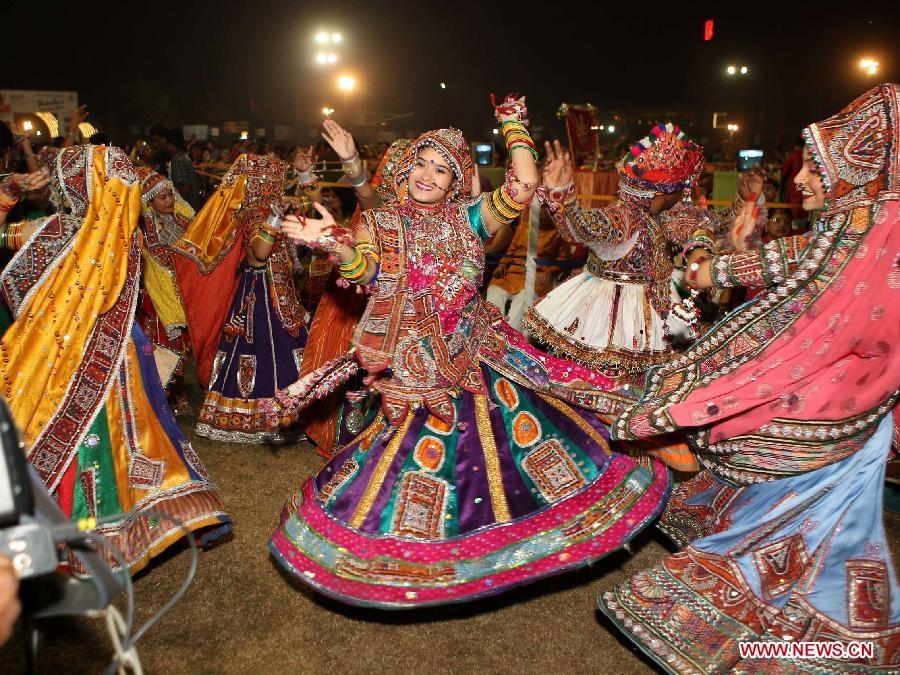 |
| Photo: Discoveringindia.net |
Navratri, a nine-day festival, honours the nine forms of Durga, the Hindu warrior goddess. The festival is celebrated in different manner across the country.
The Hindu festival of Navratri, which means nine (nav) nights (ratri) in Sanskrit, is celebrated over nine consecutive nights during the autumn. The celebrations vary across regions, according to local customs and traditions, but the main theme of the festival is the victory of good over evil. Although Navratri is devoted to goddess Durga, some states in South India also dedicate it to other Hindu deities like Saraswati, the goddess of knowledge.
Celebrating goddess Durga
The most famous story associated with Navaratri is the contest between the warrior goddess Durga and the buffalo demon Mahishasura, who was bestowed with a boon that made it impossible for any human to kill him. After their defeat by Mahishasura, the army of gods decided to consolidate their power into Durga, who triumphed over the fierce demon after a nine-day long battle. Navaratri celebrates this victory over evil, Culturetrip reported.
Durga takes nine different forms, one for each of the nine days. Every incarnation of the goddess is associated with a colour and, although not mandatory, devotees are expected to wear a specific colour on a specific day when taking part in the festivities. The first day, for example, is associated with the colour red, which symbolises energy, and the last day with sky blue signifying the beauty of nature.
This belief is mostly prevalent in the eastern region of India, including states like West Bengal, Assam, Odisha, Jharkhand and Bihar.
How Navaratri is celebrated
Navaratri is celebrated as Durga Puja in most eastern states. During this time, elaborately designed stages known as pandals, with the statue of Durga as the centrepiece, are set up in each neighbourhood. In north India, there is a 10-day fair during which the Ramlila is the main attraction. In the state of Gujarat in the west, Navaratri is one of the most important festivals. People usually fast for nine days in honour of Durga and devote all their prayers to a symbolic clay lantern, which is called garbo and is meant to represent a womb as the nucleus of all life forms. The famous garba, a spiritual dance form that originated in Gujarat, is performed during the celebrations at this time of the year.
7. Holi Festival
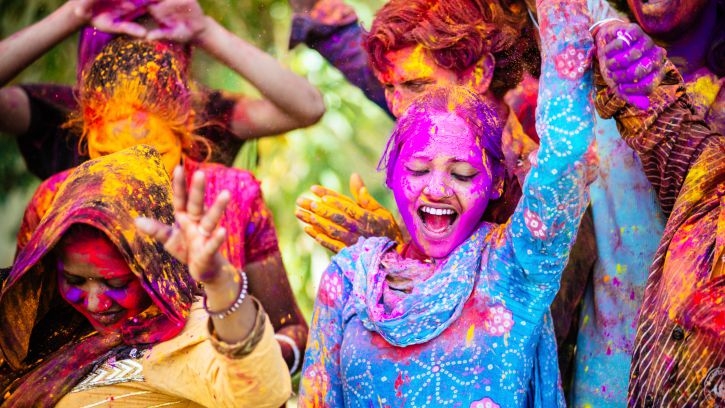 |
| Photo: TripSavvy.com |
Holi, often referred to as the "Festival of Colors", is one of the best known festivals outside of India. The festival is centered around the burning and destruction of the demoness Holika, which was made possible through unwavering devotion to Lord Vishnu.
| However, the really fun part involves people throwing colored powder on each other and squirting each other with water guns. This is associated with Lord Krishna, a reincarnation of Lord Vishnu, who liked to play pranks on the village girls by drenching them in water and colors. Bhang (a paste made from cannabis plants) is also traditionally consumed during the celebrations. Holi is a very carefree festival that's great fun to participate in if you don’t mind getting wet and dirty. |
People take extreme delight in spraying colour water on each other with pichkaris or pouring buckets and buckets of it. Singing Bollywood Holi numbers and dancing on the beat of dholak is also a part of the tradition. Amidst all this activity people relish gujiya, mathri, malpuas and other traditional Holi delicacies with great joy.
Drinks, specially thandai laced with bhang is also an intrinsic part of the Holi festivity. Bhang helps to further enhance the spirit of the occasion but if taken in excess it might dampen it also. So caution should be taken while consuming it.
Holi Celebrations in South India
In south India, however, people follow the tradition of worshiping Kaamadeva, the love god of Indian mythology. People have faith in the legend which speak about the great sacrifice of Kaamadeva when he shot his love arrow on Lord Shiva to break his meditation and evoke his interest in worldly affairs.
After, an eventful and funfilled day people become a little sober in the evening and greet friends and relatives by visiting them and exchange sweets. Holi special get togethers are also organised by various cultural organisations to generate harmony and brotherhood in the society.
Rituals of Holi
Rituals of the ancient festival of Holi are religiously followed every year with care and enthusiasm.
Preparations
Days before the festival people start gathering wood for the lighting of the bonfire called Holika at the major crossroads of the city. This ensures that at the time of the actual celebration a huge pile of wood is collected.
Holika Dahan Celebrations
Then on the eve of Holi, Holika Dahan takes place. Effigy of Holika, the devil minded sister of demon King Hiranyakashyap is placed in the wood and burnt. For, Holika tried to kill Hiranyakashyap's son Prahlad, an ardent devotee of Lord Naarayana. The ritual symbolises the victory of good over evil and also the triumph of a true devotee.
Children also hurl abuses at Holika and pray pranks, as if they still try to chase away Dhundhi who once troubled little ones in the Kingdom of Prithu. Some people also take embers from the fire to their homes to rekindle their own domestic fires.
Play of Colors
Next day, is of course the main day of Holi celebrations. The day is called Dhuleti and it is on this day that the actual play of colours take place. There is no tradition of holding puja and is meant for pure enjoyment.
The tradition of playing colours is particularly rampant in north India and even in that region, there can be no comparison to the Holi of Mathura and Vrindavan. In Maharashtra and Gujarat too Holi is celebrated with lot of enthusiasm and fun.
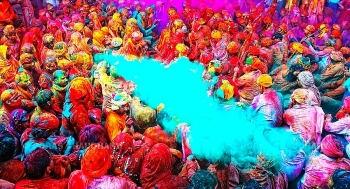 India: Top 15 Most Popular Festivals in March India: Top 15 Most Popular Festivals in March March, the month of colors, music, and entertainment, is the perfect time for experiencing the cultural beauty of India. The numerous and varied festivals offer ... |
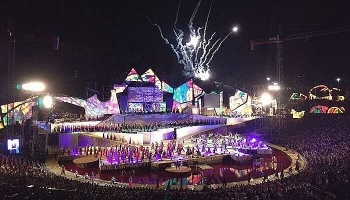 Top 10 Most Popular Festivals and Holidays in March 2021 in the World Top 10 Most Popular Festivals and Holidays in March 2021 in the World March is a great month when a diversity of events across the globe taking place. If you are wondering where to go to emerge in ... |
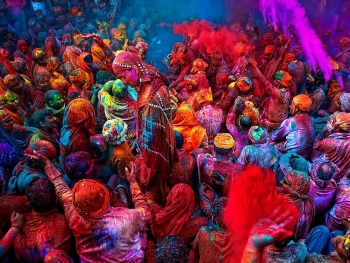 TOP 15 Most Popular Holidays and Festavals in India TOP 15 Most Popular Holidays and Festavals in India 2021 is coming with lots of vacations as well as holidays - festivals in every corner of India. Knowinsider ranked the 15 biggest or ... |
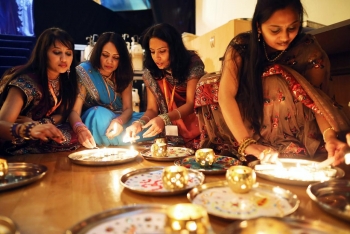 Diwali: Some interesting things you should know about this festival! Diwali: Some interesting things you should know about this festival! Diwali is known as the biggest of all Hindu festivals. If you want to know and explore more its origin, significance as well as some ... |

